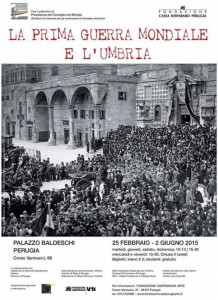 From 2014 there have been various events – and will continue until 2018 – commemorating the anniversary of the First World War. Scrolling through the newspapers you can also realize that the events covering various forms of representation, ranging from displays of memorabilia, uniforms or photographs, the presentation of projects geared to multimedia, to performances in theaters on the various forms of expression that have developed in connection with the First World War. One of the most significant events is undoubtedly the one that was organized at the Museum of the Risorgimento in Rome last year. It was a show all in all traditional, inside of which, however, has developed a way through countless documents of various kinds (photos, videos, objects, books, letters, postcards, newspapers, art, music). The Museum of the Risorgimento is the subject of reference for this historical period and has the most comprehensive archive of documents dating back to the last decades of the nineteenth century and early twentieth. In that exhibition was devoted special attention to the music scene, in respect of which had been set up a section curated by ICBSA (what used to be called Discoteca di Stato) with a series of audio recordings that gave account of the turmoil that at various levels, he had affected the music in the years of the First World War. In Perugia, Palazzo Baldeschi, ther is an exhibition like that of Rome, which makes reference, in addition to the national, also at the regional scenario. Following the path you’ll find that here too (the exhibition was opened on February 25 and will run until June 2) it has a section dedicated to the sounds of the great war. On the one hand through the entries, first and foremost that of Diaz who recites the famous bulletin of victory (on display is exposed, on a gramophone, the vinyl where it was originally recorded text). Then through the sound production, both cultured and popular. Already in the foyer of the building (overlooking Corso Vannucci) you can listen to a selection of songs produced during the war: the famous “O Gorizia” (in the version sung by Sandra Mantovani at the Festival of Two Worlds in Spoleto in 1964), in a series of Neapolitan songs (all taken from the Archives Fonografico of Naples: “Villanova” sung by Gennaro Pasqualino, ”O guaglione ‘and underworld “sung by Liliam Fuller,”Guapparia” sung by Giacomo Rondinella), until some works composed by Ottorino Respighi (“The Fountains of Rome” and “Ancient Airs and Dances for lute”, respectively 1916 and 1917) and an interesting lineup of popular tunes and historians songs. These include “Oh God of heaven”, sung by the Umbrian group Brigata Pretolana, “U Rusignu”, a trallallero registered in Liguria, “The Legend of the Piave” and “Ta-Pum”. Do not miss – as you can imagine – some expressions of Futurism: “The Battle of Adrianople 1924. Definition of Futurism” by Filippo Tommaso Marinetti and “Awekening of a city” by Luigi Russolo.
From 2014 there have been various events – and will continue until 2018 – commemorating the anniversary of the First World War. Scrolling through the newspapers you can also realize that the events covering various forms of representation, ranging from displays of memorabilia, uniforms or photographs, the presentation of projects geared to multimedia, to performances in theaters on the various forms of expression that have developed in connection with the First World War. One of the most significant events is undoubtedly the one that was organized at the Museum of the Risorgimento in Rome last year. It was a show all in all traditional, inside of which, however, has developed a way through countless documents of various kinds (photos, videos, objects, books, letters, postcards, newspapers, art, music). The Museum of the Risorgimento is the subject of reference for this historical period and has the most comprehensive archive of documents dating back to the last decades of the nineteenth century and early twentieth. In that exhibition was devoted special attention to the music scene, in respect of which had been set up a section curated by ICBSA (what used to be called Discoteca di Stato) with a series of audio recordings that gave account of the turmoil that at various levels, he had affected the music in the years of the First World War. In Perugia, Palazzo Baldeschi, ther is an exhibition like that of Rome, which makes reference, in addition to the national, also at the regional scenario. Following the path you’ll find that here too (the exhibition was opened on February 25 and will run until June 2) it has a section dedicated to the sounds of the great war. On the one hand through the entries, first and foremost that of Diaz who recites the famous bulletin of victory (on display is exposed, on a gramophone, the vinyl where it was originally recorded text). Then through the sound production, both cultured and popular. Already in the foyer of the building (overlooking Corso Vannucci) you can listen to a selection of songs produced during the war: the famous “O Gorizia” (in the version sung by Sandra Mantovani at the Festival of Two Worlds in Spoleto in 1964), in a series of Neapolitan songs (all taken from the Archives Fonografico of Naples: “Villanova” sung by Gennaro Pasqualino, ”O guaglione ‘and underworld “sung by Liliam Fuller,”Guapparia” sung by Giacomo Rondinella), until some works composed by Ottorino Respighi (“The Fountains of Rome” and “Ancient Airs and Dances for lute”, respectively 1916 and 1917) and an interesting lineup of popular tunes and historians songs. These include “Oh God of heaven”, sung by the Umbrian group Brigata Pretolana, “U Rusignu”, a trallallero registered in Liguria, “The Legend of the Piave” and “Ta-Pum”. Do not miss – as you can imagine – some expressions of Futurism: “The Battle of Adrianople 1924. Definition of Futurism” by Filippo Tommaso Marinetti and “Awekening of a city” by Luigi Russolo.
Questo post è disponibile anche in: Italian

 English
English Italiano
Italiano 





Leave a comment
You must be logged in to post a comment.